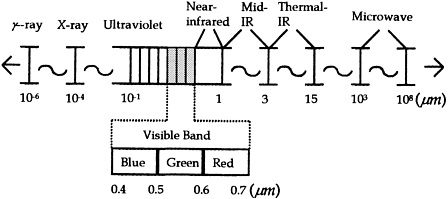279.
| [Cover] [Contents] [Index] |
Page 5
1.1 Introduction to remote sensing
Remote sensing is the use of sensors installed on aircraft or satellites to detect electromagnetic energy scattered from or emitted by the Earth’s surface. This energy is associated with a wide range of wavelengths, forming the electromagnetic spectrum. Wavelength is generally measured in micrometres (1×10−6 m, μm). Discrete sets of continuous wavelengths (called wavebands) have been given names such as the microwave band, the infrared band, and the visible band. An example is given in Figure 1.2, which shows only a part of the overall electromagnetic spectrum. It is apparent that the visible waveband (0.4 to 0.7 μm), which is sensed by human eyes, occupies only a very small portion of the electromagnetic spectrum.
A specific remote sensing instrument is designed to operate in one or more wavebands, which are chosen with the characteristics of the intended target in mind. Thus, a sensor designed to detect electromagnetic radiation in the visible spectrum that has been reflected by chlorophyll in ocean waters will use different wavebands than would a sensor designed to detect the characteristics of soils. Apart from the reflectance characteristics of the target, an important factor governing the choice of waveband is the effect of interactions between the atmosphere and electromagnetic radiation. Such radiation passes downwards through the atmosphere on its way from the Sun to the Earth, and reflected radiation passes upwards through the atmosphere on its way from Earth to the sensor. Absorption and scattering are the main mechanisms that alter the intensity and direction of electromagnetic radiation within the atmosphere. In some regions of the optical spectrum, these mechanisms (principally absorption) ensure that remote sensing is impossible. Spectral regions of lower absorption are known as

Figure 1.2 Regions of the electromagnetic spectrum that are of interest in remote sensing applications.
| [Cover] [Contents] [Index] |
EAN: 2147483647
Pages: 354